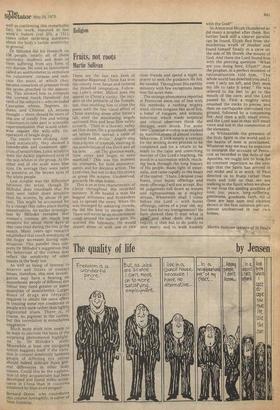01' blue eyes and others
Bernard Dixon
Response to pain varies enormously from one person to another, as any dentist or fast bowler will tell you. Aside from squeamishness or toughmindedness, which can influence our apparent reaction,' there is a considerable and genuine variation in pain thresholds throughout the population.
An unexpected example of this is the differing sensitivity of the cornea — the transplant 'window' covering the front of the eyeball. Opticians are aware, from their experience of fitting contact lenses, that some folk feel real discomfort. 'as a result of manipulations that would cause no sensation whatever in others. There have been suspicions that this is related to the .colour of a person's eyes, though no :conclusive proof — indeed, it was difficult to see why the pigmentation of the iris should influence the cornea in this way.
Now the matter has been settled. Michel Millodot, working in the University of Wales Institute of Science and Technology, Cardiff, has established that blue-eyed people have more sensitive corneas than those with brown eyes. As
Well as confirming this remarkable fact, his work, reported in last week's Nature (vol 255, p 151), raises other surprising questions
about the body's tactile sensitivity in general.
Dr Millodot did his research on 156 people, nearly all of them university students and none of them suffering from any form 4)f eye disease. He used an instrument
called an aesthiometer to stimulate his volunteers' corneas and indicate the point at which they became conscious of pressure from the probe attached to the apparatus. This allowed him to compute the 'corneal touch threshold' for each of his subjects — who included Caucasian whites, Negroes, Indians, and Chinese. (A serious
thought — there should be more of this use of totally free and willing volunteers to take part in scientific experimentation that would other wise require the willy-nilly cooperation of beagle dogs.)
The results were striking. Analysed statistically, they showed a considerable and consistent spec
trum of sensitivities. Least sensitive were the darkly pigmented eyes of the non-whites in the group. At the
other end of the scale were blue eyes. On average they were twice as sensitive as the brown eyes of the white people.
Less notable was the difference between the sexes, though Dr Millodot does vouchsafe that his men were rather more sensitive
than his women, by about 10 per
Cent. This might be accounted for by a change that takes place during
menstruation. An earlier investigation by Millodot revealed that women's corneas are much less sensitive for about three days at that time than during the rest of the
month. Many years ago research established that touch sensitivity of the finger decreases during men struation. This parallel thus supports Dr Millodot's suggestion that
the behaviour of the cornea may reflect the sensitivity of other tissues in the body too. As well as being of interest to wearers and fitters of contact lenses, therefore, this new investigation may have a bearing on anaesthesia: people of different eye colour may need greater or lesser quantities of anaesthetics. Larger doses of drugs are certainlY required to obtain the same effect in treating some eye conditions in People with dark rather than lightly
Pigmented irises. There is, of course, no pigment in the cornea, but this correlation is nonetheless
suggestive. Much more work now needs to be done to uncover the basis of the
surprising phenomenon highlighted by Dr Millodot's study. Meanwhile at least one intriguing notion suggests itself if the varia
tion in corneal sensitivity betWeen
People of differing eye colour Should indeed indicate more gen eral differences in other body tissues. Could this be the explana tion of why acupuncture has been developed and found wider acceptance in China than in countries inhabited by blue-eyed people?
Bernard Dixon, who contributes this column fortnightly, is editor of New Scientist.



























 Previous page
Previous page